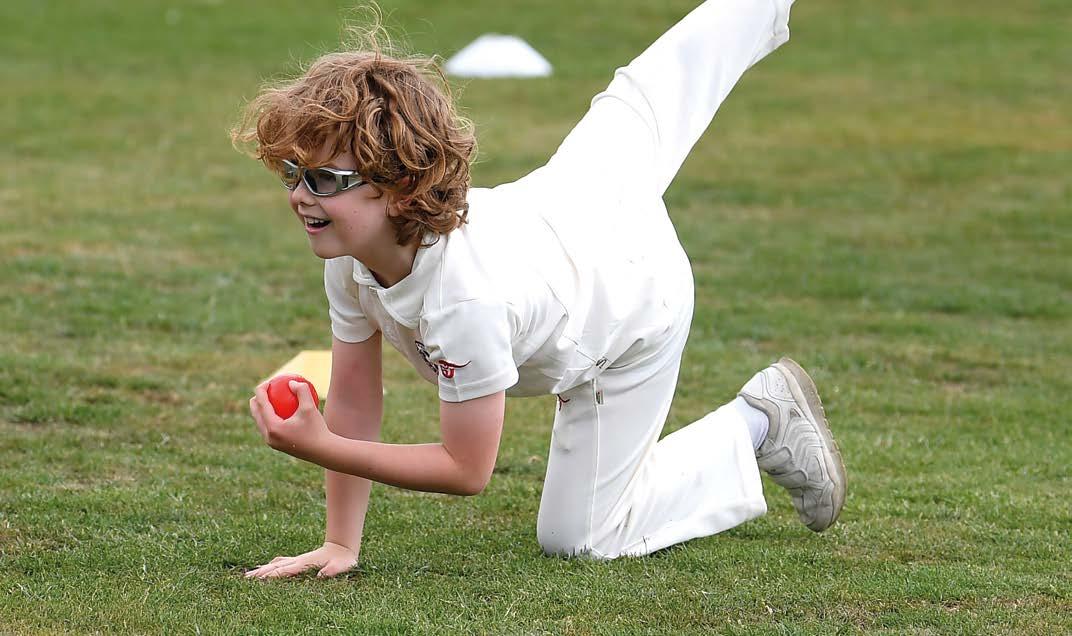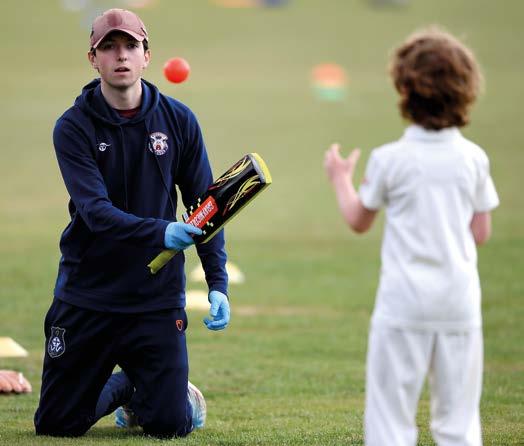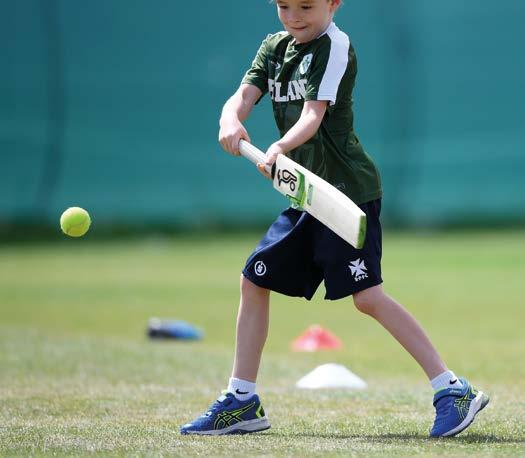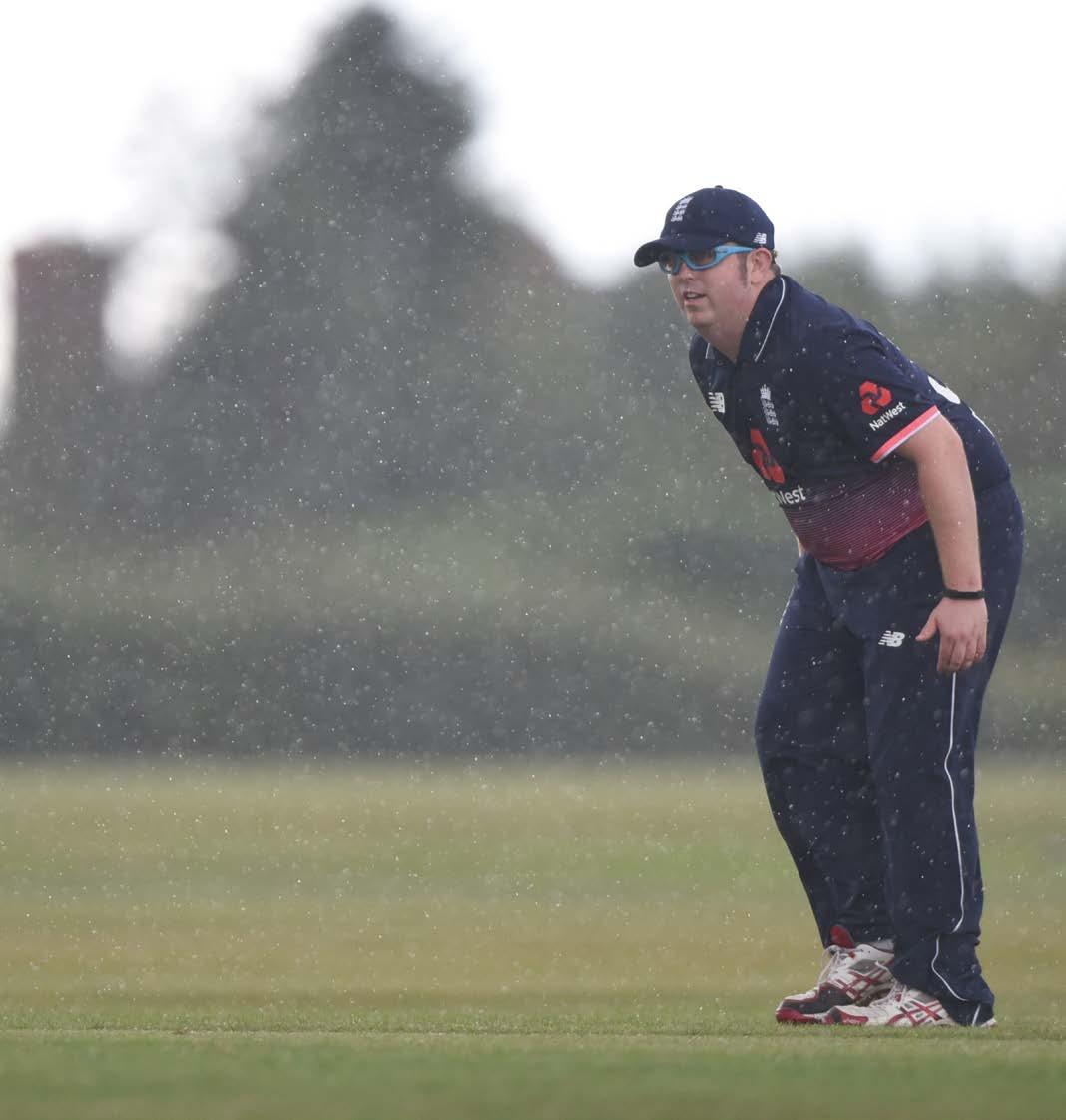
12 minute read
Juniors

Inspiring generations: Top tips for a thriving juniors section
WIMBLEDON DIRECTOR OF CRICKET JONATHAN SPELLER OFFERS ADVICE TO CLUBS ON HOW TO MOTIVATE AND ORGANISE DIFFERENT AGE GROUPS
Last August, Jonathan Speller was voted The Cricketer’s Lockdown Club Hero after masterminding a programme at Wimbledon CC to allow more than 750 youngsters to continue playing cricket during the coronavirus pandemic.
As Wimbledon’s director of cricket, he is responsible for the club’s cricket operations, overseeing an explosion in junior engagement and the development of a girls’ section during his three years in the role.
And, despite the pandemic, the last year has been no different. As soon as lockdown restrictions were eased, Speller created more than 4,000 sessions for local children and a summer camp scheme which sold out inside 48 hours to provide a safe and supervised environment for kids to stay active.
A coach with more than 20 years’ experience, Speller discusses his coaching philosophy and shares his tips for maintaining a successful junior section.
WIMBLEDON’S COACHING PHILOSOPHY
Under-8s: Physical literacy, not cricket technique My coaching philosophy has been inspired by teaching
and psychology. When you’re young, you’re unconsciously incompetent – you don’t know what you don’t know. If you bombard a six-year old with technique, they’ll have no idea why they should be doing it. At Wimbledon it’s about physical literacy, getting them engaging with their friends and doing the fundamentals.
This is where the ECB’s All Stars Cricket programme is brilliant because it’s pure physical literacy. Can you balance, can you communicate, can you run fast, can you catch, can you throw? All Stars send you kit – a bat and ball for each child – which is a great starting point, while another advantage of physical literacy is you can use parent volunteers. They don’t need any specific skills and if you can engage a couple of them in a session then your coach to player ratio explodes.
Under-12s: Encourage experimentation When they reach under-9s, they’re consciously incompetent – they know what they can’t do – and understand better how their bodies work. That’s when you can start doing the fundamental teaching with a Level 2 coach.
You’ll see personalities come out at this point – those who are risk averse and won’t try to hit the ball hard, and the risk takers who’ll try to hit anything – and we encourage that experimentation.
With bowlers, as long as they’re bowling with a straight arm and their action is safe, great! What’s dangerous if you start coaching too soon is you pigeon-hole people. If someone says, “you’re quite a good fast bowler”, all of sudden that’s what you do. I don’t believe in that. Bowl fast, spin or swing, I want them to experiment.
12 and over: Teach the game Here we move to game-based theory and practice, teaching them nuances and learning the actual game. We’re looking for open dialogue with the kids because in teaching, if the teacher is doing 80 per cent of the work and the kids are doing 20 per cent, they’re not really learning. Our coaches throw ideas out there and get the kids asking why or challenge them to explain why. Setting up a junior section: Getting started My big advice is, if you’re thinking about setting up a junior section, just start! There are lots of free resources available and volunteers will always step forward if you’ve got a common goal. Also, engage with your county board. We’re a big cricket family and if you ask, people will help.
You’ve got to think about your legal and safeguarding policies. This includes DBS checks for coaches and volunteers, sticking to ECB ratios of coaches to players (especially when using hard balls) and having permission for photos. Appoint a club welfare officer and use the resources available on the ECB website to make sure you’re ticking all the boxes.
And think about the admin side, how you’re going to communicate with parents, manage membership etc. We use an app called Spond (although there are others) which is a real time-saver.

Attracting players Take advantage of what’s out there. All Stars is excellent here because it’s a public forum where people put their location in and are matched to clubs in their area. Social media is good for catching parents too but our big one is holiday camps. Someone might not want to commit to a full season but a few days at cricket camp gives them a feel for it.
We’ve pushed a lot harder on our summer camps recently. The emphasis is on them being young kids and having fun, and the early drop-off and late pick-ups help local parents during a long summer. Open them to members and non-members to attract as many kids as possible.
Create a group identity Have a uniform. It sounds silly but a uniform brings people together and creates a community sense. In our club it helps to level the playing field amongst the kids – it doesn’t matter if you’re private school or state school, high or low economic background, you have a collective love of one thing and a pride of the badge. As Wimbledon, we’re a family and that’s what it’s all about.



Be flexible One of the first things I looked at was the pressure on kids to move onto hardball at a certain age, something I think can be a huge turn-off. Instead, be flexible. We created a softball programme to keep more kids at the club.
Also, all our session plans include the next step up or down – e.g. using a smaller ball or a bigger ball – to challenge/help the kids while one to one coaching and nets are always available for those looking for something extra.
Setting up a girls’ section Starting a girls’ section from scratch is like starting any junior section. You just want to engage and inspire, and now girls’ cricket is taking off in schools, you have loads more girls who are interested!
At Wimbledon, up to under-9s we don’t split them because there’s no difference up to this stage on their learning journey. They’re split after that, but that’s only because some girls prefer to play girls’-only. However our girls sessions and boys sessions are run at the same time and any girls who want to join in with the boys can! Our coaches are always adaptable and allow players to swap in between sessions.
We don’t have a ‘girls’ night’ because we want them to see themselves as cricketers, not ‘female cricketers’. However. having a girls’ night does have its advantages – it creates a community. At my old club, Friday night was girls’ night, and they’d have pizza after training. But, as long as you’re engaging, enthusing and inspiring, you do what works for your club.
Remember, your job isn’t to create the next England star People might ask why I don’t push the kids harder but that’s not my job. My job is to inspire you to play into your 40s, 50s, 60s with your kids and grandkids. Instead, make a good connection with your county set-up and their elite programme. If someone shows promise, you can put them on that pathway where they can be challenged further, but don’t run the risk of putting kids under pressure.
I also don’t subscribe to kids playing up a year. Future leaders learn in the safety and confines of their peer age. Usually, the young guy or girl in the side doesn’t stride into an older age group as a leader, again pigeon-holing them into a role in the team. If they need challenging, encourage the better players to mentor their team-mates or younger age groups and develop those softer skills and learn from teaching others.
FIVE KEY STEPS FOR SETTING UP A JUNIOR SECTION
Use the available resources, such as your local county board and the ECB’s All Stars programme.
Get your ECB Clubmark – it’s official accreditation of your legal and safeguarding policies and shows you’re ticking all of the boxes.
Think about your community – will holiday camps be a great starting point? Do you want a uniform?
Treasure your parent volunteers - they keep the kids engaged and are a free resource who are giving up their time around the club.
Emphasise physical literacy and cricket skills instead of technique for younger age groups.
Cricket for everyone?: The experiences of a disabled cricketer

OLIVER THORPE DETAILS THE OPPORTUNITIES AVAILABLE TO DISABLED PLAYERS IN ENGLAND AND WALES IN 2021
Being a disabled cricketer can be quite the challenge: some levels of the recreational game are too easy, some are too hard.
It’s all about finding the right level for you, which you’ll find by ticking three boxes: if you’re comfortable, not putting yourself in danger and, most importantly, you’re enjoying it.
There are a number of ways that a cricketer with a disability can get involved in the game. They may choose to play able-bodied cricket, hard-ball cricket, soft-ball cricket or even visually impaired cricket.
Over the last few years, the ECB has done a lot to ensure that the disability game is being recognised, and more and more we’re starting to see clips go viral on social media –

it’s extraordinary to say the least.
Now, you may be sitting as a disabled cricketer thinking ‘how do I get involved?’ or a club thinking ‘how do we start up disability cricket?’ – well fear not, there is a way and you’ve come to the right place.
As a disabled cricketer, speak to local clubs in your area and see what they have to offer. They may offer the formats mentioned above and if they don’t, it may be worth having a chat about how you can get involved.
If there are no clubs nearby, then reach out to your local county cricket board or foundation and see what they have available. The ECB and Lord’s Taverners do loads throughout the year, catering for all forms of disability.
At university, I was fortunate enough to represent Lancashire and help them reach the semi-finals of the ECB D40 competition in 2018. This was a hard-ball 40-over competition for players with a hearing impairment, learning disability or a physical disability, with counties from all over the country taking part. A full list of competing counties is available on the ECB website.
Search out programmes such as the Super 9s, Super 1s and table cricket. For young children, the ECB’s Dynamos Cricket and All Stars Cricket programmes are available to youngsters of all abilities.
For players with a visual impairment, Super 9s or D40 cricket is not an option. Instead, you have the BCEW regional league and the BCEW national league.
At this stage, you’re on the pathway to becoming an England cricketer and one step closer to pulling on the Three Lions. There is a Lions programme in the respective disciplines, bridging the gap between county level and the international scene.
If there’s a club out there that wants to get involved, then you could approach your county cricket board or foundation to see what assistance they can offer. They will have officers that may be able to facilitate in helping you get set up and answer any questions that you may have.
Alternatively, you could approach the ECB directly and they will help you gain access to their Champion Club programme. The programme is designed to give clubs a helping hand in making the game more accessible in their community. They will offer you guidance, resources and equipment to help you achieve this. It will allow for all members of your community regardless of ability to get involved in the game whether it be as a player, official, volunteer or a follower.
Each champion club will receive a free kit bag containing plastic equipment and a variety of balls and markers to help coaches.
If your club becomes an ECB champion, you will be able to access ECB funding to support the delivery and funding of inclusive sessions. A full list of how a club can get involved with this scheme can be found on the ECB’s website.
The programmes mentioned in this piece are a fabulous way of engaging all members of society, ensuring that cricket is seen as a game for all and making clear that the entire community can get involved, no matter their ability.
It is fantastic to see the ECB actively engaging with the disability game and putting in every effort to make it visible, at every level. Hopefully in a post-pandemic world we will hear more about the disabled game and be able to watch it grow and inspire those who previously thought that our great sport wasn’t for them. Cricket will always be a game for everyone. Don’t let anybody tell you anything different.
FIVE QUICK STEPS TO ESTABLISHING A DISABLED SECTION AT YOUR CLUB
SPEAK TO YOUR COUNTY BOARD
Get in touch with your local county board, they’ll be able to help your club get on the ladder and get you on your way to supporting the disabled game.
CONTACT THE ECB
There are people at the national governing body who will be happy to help you get started with disability cricket. They’ll point you in the right direction and make sure you the support you need.
REACH OUT TO LORD’S TAVERNERS
The Lord’s Taverners charity will be able to assist you in setting up disability cricket at your club. They’ll be able to give tips and advice on how to go about things.
GAUGE INTEREST
Make sure you speak to relevant members of your community and ensure there are enough people willing to participate.
RAISE AWARENESS
Spread the word on social media. Make sure the people that need to see it do so by tagging them. You’ll get players from nearby towns and cities turning out so ensure that you’re prepared.
GOOD GEAR GUIDE
32 INTRODUCTION
34 BATS
44 BOUTIQUE BATS
50 SOFTS 52 STRETTON FOX
54 HOW TO BUY A BAT
57 TESTING DAY







